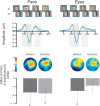Early identity recognition of familiar faces is not dependent on holistic processing
- PMID: 30247645
- PMCID: PMC6204488
- DOI: 10.1093/scan/nsy079
Early identity recognition of familiar faces is not dependent on holistic processing
Abstract
It is widely accepted that holistic processing is critical for early face recognition, but recent work has suggested a larger role for feature-based processing. The earliest step in familiar face recognition is thought to be matching a perceptual representation of a familiar face to a stored representation of that face, which is thought to be indexed by the N250r event-related potential (ERP). In the current face-priming studies, we investigated whether this perceptual representation can be effectively activated by feature-based processing. In the first experiment, prime images were familiar whole faces, isolated eyes or isolated mouths. Whole faces and isolated eyes, but not isolated mouths, effectively modulated the N250r. In the second experiment, prime images were familiar whole faces presented either upright or inverted. Inverted face primes were no less effective than upright face primes in modulating the N250r. Together, the results of these studies indicate that activation of the earliest face recognition processes is not dependent on holistic processing of a typically configured face. Rather, feature-based processing can effectively activate the perceptual memory of a familiar face. However, not all features are effective primes as we found eyes, but not mouths, were effective in activating early face recognition.
Figures


Similar articles
-
Electrophysiological evidence for parts and wholes in visual face memory.Cortex. 2016 Oct;83:246-58. doi: 10.1016/j.cortex.2016.07.022. Epub 2016 Aug 9. Cortex. 2016. PMID: 27614900
-
Holistic face perception is impaired in developmental prosopagnosia.Cortex. 2018 Nov;108:112-126. doi: 10.1016/j.cortex.2018.07.019. Epub 2018 Aug 6. Cortex. 2018. PMID: 30165324
-
Revisiting the earliest electrophysiological correlate of familiar face recognition.Int J Psychophysiol. 2017 Oct;120:42-53. doi: 10.1016/j.ijpsycho.2017.07.001. Epub 2017 Jul 4. Int J Psychophysiol. 2017. PMID: 28684327
-
Repetition effects in human ERPs to faces.Cortex. 2016 Jul;80:141-53. doi: 10.1016/j.cortex.2015.11.001. Epub 2015 Nov 18. Cortex. 2016. PMID: 26672902 Review.
-
The neural dynamics of familiar face recognition.Neurosci Biobehav Rev. 2024 Dec;167:105943. doi: 10.1016/j.neubiorev.2024.105943. Epub 2024 Nov 16. Neurosci Biobehav Rev. 2024. PMID: 39557351 Review.
Cited by
-
The role of the eye region for familiar face recognition: Evidence from spatial low-pass filtering and contrast negation.Q J Exp Psychol (Hove). 2023 Feb;76(2):338-349. doi: 10.1177/17470218221085990. Epub 2022 Apr 1. Q J Exp Psychol (Hove). 2023. PMID: 35195031 Free PMC article.
-
Distortions of lip size bias perceived facial attractiveness.Proc Biol Sci. 2025 Apr;292(2044):20250202. doi: 10.1098/rspb.2025.0202. Epub 2025 Apr 9. Proc Biol Sci. 2025. PMID: 40199352 Free PMC article.
-
Artistic expertise shapes face perception: An alpha frequency and N170 study on portraiture.Neuroimage Rep. 2022 Jul 20;2(3):100117. doi: 10.1016/j.ynirp.2022.100117. eCollection 2022 Sep. Neuroimage Rep. 2022. PMID: 40567302 Free PMC article.
-
Learning facilitates dual-process face recognition regardless of holistic processing.Mem Cognit. 2023 Aug;51(6):1416-1430. doi: 10.3758/s13421-023-01399-2. Epub 2023 Mar 8. Mem Cognit. 2023. PMID: 36884192
-
Face Recognition Deficits in a Patient With Alzheimer's Disease: Amnesia or Agnosia? The Importance of Electrophysiological Markers for Differential Diagnosis.Front Aging Neurosci. 2020 Dec 21;12:580609. doi: 10.3389/fnagi.2020.580609. eCollection 2020. Front Aging Neurosci. 2020. PMID: 33408626 Free PMC article.
References
-
- Begleiter H., Porjesz B., Wang W. (1995). Event-related brain potentials differentiate priming and recognition to familiar and unfamiliar faces. Electroencephalography and Clinical Neurophysiology, 94(1), 41–9. - PubMed
-
- Bruce V., Young A. (1986). Understanding face recognition. British Journal of Psychology, 77(3), 305–27. - PubMed
-
- Burton A. M., Bruce V., Johnston R. A. (1990). Understanding face recognition with an interactive activation model. British Journal of Psychology, 81 (Pt 3), 361–80. - PubMed
Publication types
MeSH terms
LinkOut - more resources
Full Text Sources
Other Literature Sources
Medical

